What to do in Rhodes when it Rains: 7 Must-See Indoor Activities (Rainproof Guide)
If you think a downpour can ruin your adventure in Rhodes, think again! This wonderful Greek island offers a unique experience even in the rain. In this itinerary, we will guide you through the cultural gems and relaxing spots that shine even on cloudy days. You will discover how the city’s colors intensify with the rain, while the aromas of coffee and taverns blend with the fresh air. Prepare your umbrella and let yourself be inspired by a Rhodes that knows how to surprise, even when the clouds gather!
Rain in Rhodes, especially off-season (like in October), can be unexpected. But a downpour doesn’t mean the vacation is ruined! The island is rich in history and culture, much of which is housed in magnificent indoor spaces. Here is a guaranteed itinerary to turn a rainy day into a rich and relaxing experience.
⚠️ TRAVEL HACK ALERT: Your most useful resource is at the bottom! Find our Interactive Rhodes City Rainy Day Map immediately after the conclusion. Scroll down the article for your complete rain-proof guide.
Rhodes Old Town: The Secret Magic of a Rainy Day Walk 🌧️
Discover the magic of Rhodes Old Town on a rainy day! The cobblestone streets, ancient walls, and historic monuments glisten with a unique charm under the rain. Join us as we uncover the secrets of this enchanting place, ideal for travelers seeking unexpected adventures. You will discover hidden corners, cozy cafés, and the romantic atmosphere that makes Rhodes an unmissable destination even when the clouds gather.
Table of Contents for What to do in Rhodes when it Rains
🌧️ Rhodes When It Rains: The Ultimate Guide to a Perfect Vacation
Rain in Rhodes, especially out of season (like October), can be unexpected. But a downpour doesn’t mean your vacation is ruined! The island is rich in history and culture, much of which is housed in magnificent indoor spaces .
Here’s an itinerary guaranteed to turn a rainy day into a rewarding and relaxing experience.
1. Main Indoor Activities in the Old Town (UNESCO)
Rhodes Old Town is your primary refuge. With its imposing walls and structures, it offers hours of sheltered exploration.
🏰 Morning: Immersion in the Centuries
- Palace of the Grand Master of the Knights (Kastello): This is the most iconic fortress and the ideal destination. Explore the grand halls, mosaics, and exhibitions while staying completely dry. The Palace is extensive and requires several hours for a complete visit.
- Archaeological Museum of Rhodes: Located in the marvelous former Hospital of the Knights, it offers a unique setting. Its collections of sculptures and ancient artifacts are displayed in long galleries and covered courtyards. Being close to the Palace, you minimize outdoor travel.
☕ Lunch and Historical Relaxation
- Refuge in the Tavernas: Choose one of the intimate and traditional tavernas in the Old Town. Instead of rushing your meal, sit down calmly and enjoy the most comforting Greek specialties (like a Stifado or a Fasolada).
2. Rainproof Alternatives Outside the Walls
If you’ve already explored the Old Town or are looking for something different, these destinations will keep you dry.
- 🐠 The Rhodes Aquarium: A unique experience. Housed in a 1930s Art Deco building, the aquarium is located in the basement and utilizes the tunnel architecture of the former marine research facilities. It’s a brief but fascinating dive into the underwater world of the Aegean.
- 🛒 Shopping and Coffee at the New Agora: The covered market (near the port) is a lively place where you can stroll sheltered, look for local souvenirs, and sit in one of the indoor cafes for a hot Greek coffee, enjoying the local hustle and bustle.
- 🍷 Wine and Gastronomic Tastings: Rain is the perfect excuse to indulge in the pleasures of the table. Find a wine bar in the city that organizes tastings of Aegean or Rhodian inland wines. A glass of wine and mezedes (appetizers) are the ideal way to conclude a rainy afternoon.
The 7 Must-Do Indoor Activities
To answer the question, “What to do in Rhodes when it rains?”, the Old Town (a UNESCO World Heritage site) and its immediate vicinity offer the best shelters. For list lovers, here are the 7 things you absolutely must do, divided by their nature:
- Cultural Immersion: Palace of the Grand Master of the Knights
- Archaeological Journey: Archaeological Museum of Rhodes
- Gourmet Refuge: A Slow Lunch in a Historic Tavern
- Underwater World: Rhodes Aquarium
- Indoor Shopping: New Agora (Market)
- Relaxing Break: Local Wine and Ouzo Tasting
- Sacred History: Visit the Byzantine Churches sheltered from the rain
🚗 Practical Logistics: Moving and Parking in the Rain
Dealing with the rain in Rhodes requires a little strategy to avoid getting too wet.
🚕 Transportation: Car, Taxi, or Bus?
- Rental Car (Ideal): The best solution. It gives you complete autonomy and allows you to quickly get to your destination.
- Taxi (Practical): For short trips within the city, taxis are an excellent and quick option, especially if you don’t want to look for parking. They’re easily found in the New Town.
- Bus (Economy): Urban lines are reliable, but you’ll still have to walk to and from stops, so a good umbrella is essential.
🅿️ Useful Parking (for the Old City)
If you arrive by car, you cannot enter the Old City. Park outside:
- Porto Mandraki Parking (Main Port): The most convenient option. It’s a large paid parking lot right in front of the walls, near the Grand Master’s Palace. Perfect for rainy days because it minimizes the walking distance to the entrance.
- Free Parking (Outside the Porte d’Amboise): Further away but free. Ideal if the weather is good, but less recommended if the downpour is heavy.
🧣 In October: Clothing Tips (Anti-Rain)
October in Rhodes is a transitional season: you can experience hot summer sun, but also sudden winds and rain. The key is to dress in layers .
| Category | What to Bring | Why It’s Necessary in October |
| Outer Layer | Rain Jacket/K-way (Essential) | It doesn’t have to be heavy, but waterproof . Perfect for folding into a backpack. |
| Middle Layer | Sweatshirt or Lightweight Cardigan | Useful in the evening, in the morning and especially in museums , where the air is fresh. |
| Legs | Long Pants or Jeans | Better than shorts; they’re more suitable for indoor spaces, cultural sites, and cool evenings. |
| Feet | Comfortable Closed Shoes (Waterproof) | Avoid canvas shoes. The cobblestone streets of the Old City are slippery and get wet easily. |
| Accessories | Compact Umbrella | A lifesaver for unexpected downpours between one destination and another. |
With a good jacket, an umbrella, and this itinerary, the rain will be nothing but a suggestive backdrop to your cultural adventure in Rhodes. Enjoy your trip!
💡 Note on Prices and Hours (A Tip From Friends)
This narrative is the result of our real-life experience in Rhodes on October 3, 2025.
All entrance fees (Grand Master’s Palace €20, Archaeological Museum €10) and opening hours (such as the evening museum closing time) were valid at the time of our visit.
We are sharing this information as we would with a friend, providing a solid foundation for your trip. For anyone traveling to Rhodes, we recommend that it is always good practice to check official websites in advance for any changes, as prices and hours can vary. However, what you find here is a reliable indication of what to expect and how to prepare!
The Tripilare Experience in Rhodes in the Rain: Lived Advice (October 3, 2025)
We begin by recounting our real-life experience of the anti-rain plan that was put to the test. We left Lindos at 9:30 AM, and although it was only cloudy initially, the arrival in Rhodes was greeted by heavy and abundant rain.
🌧️ Logistics and Driving in Extreme Conditions
Facing the rain in Rhodes, especially off-season (early October in our case), requires a driving strategy:
- Driving and Roads: With the rain, it is essential to drive cautiously and slower. The roads, even the wide two-lane ones toward Rhodes, tend to flood very quickly, practically turning into rivers after just a few hours of rain.
- Vehicle Tip: We would advise renting a car that is not too small but has a slightly higher chassis if traveling off-season with the risk of downpours, to avoid issues with inches of water on the road.
- Parking: For access to the Old Town, we headed toward the most convenient parking, noting there are various options, including street parking around the Castle perimeter.
Video – Rhodes When It Rains: The Real Challenge of Flooded Roads
Be Careful When Driving in a Downpour: As mentioned, the experience can be a real challenge. If it’s pouring with rain, we recommend carefully considering your car usage, but if you drive carefully and have a suitable vehicle (preferably an SUV or a car with higher ground clearance), the situation is manageable. Especially in areas outside the city, water can accumulate quickly.
Extreme Driving Tip: Want to see just how fast the roads flooded? We filmed the driving conditions firsthand when the rain was heaviest. [Click here to watch the full video on our YouTube Channel (Extreme Weather Log!)]: https://youtu.be/SwAn824nmic.
🧣 Attire: The Secret is Layering
The weather in Rhodes proved to be very volatile: it rained heavily, then stopped, then started again, forcing us to constantly open and close the umbrella and put on and take off our jackets.
- Light Layers: Don’t dress too heavily, scared off by the rain. The key is light attire underneath (t-shirt and shorts or light long pants). It was October, a month when swimming is still possible in Rhodes.
- Essential Outer Layer: A not-too-heavy, waterproof jacket with a hood proved essential. It must be comfortable to tie around the waist or store in a bag when the sun comes out and it gets warm.
- Shoes: We wore comfortable, closed shoes with rubber soles (protected sneakers work well), perfect for both long walks and tackling the rain, avoiding the slippery cobblestone streets.
Conclusion: Being appropriately dressed, we were perfectly comfortable and could enjoy the day. The secret is that being adequately covered allows you to stay outdoors without problems.
1. Main Indoor Activities in the Old Town (UNESCO)
Discover the enchanting indoor experiences awaiting you in the historic Old Town, a UNESCO World Heritage site. From captivating museums that unveil the region’s rich history to charming galleries showcasing local art, each venue offers a unique glimpse into the cultural tapestry of this remarkable area. Whether you’re exploring ancient architecture or indulging in delightful local cuisine, the Old Town promises an unforgettable adventure within its storied walls.
🏰 Cultural Immersion (Rain-Proof)
We decided to focus the morning on the safest refuge.
Palace of the Grand Master of the Knights (The Ideal Shelter)
This castle proved ideal when it rains, as you can take refuge inside, almost unaware of the heavy rain falling outside.
- Visit Duration: The complete visit, including the small initial museum, took us about two hours (we entered at 11:30 AM and left around 1:18 PM).
- The Route: Immediately after the staircase, the visit begins with a small museum illustrating the history of Rhodes’s port and the evolution of architecture on the island.
- A Dive into Italian Heritage: It’s interesting to note how the furnishings in many halls (chandeliers, chests) come from various parts of Italy—a legacy of the castle’s reconstruction in the 1930s by the Italian government.
- The Historical Video: Although historical details are not always clear on the exhibit labels, one room projects an engaging video with costumed characters recounting the history of the Knights of Rhodes (from the founding, to the conquest of Rhodes, up to the retreat to Malta).
2. Archaeological Museum of Rhodes (The Beauty of the Container)
We opted to visit the Archaeological Museum when it started raining again in the afternoon.
- The Real Highlight: Although the artifacts (Roman mosaics, Hellenistic statues, vases) are interesting, the building itself (the Knights’ Ancient Hospital) is worth the €10 entrance fee alone. The stone arches, courtyards, and atmosphere make it an engaging stop.
- Flexible Hours: Museums are open late (until 8:00 PM), which allows you to take advantage of the sun when it’s out and seek refuge indoors when the downpour returns.
Video – 🏰 Rhodes: The Real Reason to Visit the Archaeological Museum (The Ancient Hospital of the Knights)
The real reason to pay €10: When the skies closed again, the Archaeological Museum was our second refuge. The real reason to visit is not just the artifacts, but the building itself: the Ancient Hospital of the Knights. Entering is like entering a castle. To give you a fuller idea of the majesty of the space and courtyard, check out this short video we’ve prepared, focusing specifically on the historic and evocative architecture of the Hospital.
Watch the video directly on this page, or click here for the highest quality 4K viewing on YouTube (ideal for mobile users): https://youtu.be/kNXP_w7cbtA.
🍝 The Gourmet Refuge: Lunch and Greek Flavors
Despite it being only the beginning of October, lunch spots were packed, likely because many tourists, unable to go to the beach, flocked to the city.
- The Taverna Experience: Just a few steps from the Knights’ Palace, we took refuge at Mama Sophia Taverna.
- What We Ate: To sample several Greek dishes, we opted for a Mixed Platter for two people (cost €50), which included moussaka, meatballs, stifado beef, giant beans, Greek salad, and fruit with honey.
- Note on Flavors: Be aware of the abundant use of onion in typical Greek dishes!
🛍️ Alternative Exploration: Old Town and Shopping
During moments when the rain gave us a break or was lighter, we explored the center:
- Street of the Knights: Very easy to find after exiting the Castle; just turn left immediately.
- Shopping and Atmosphere: The Old Town does not have a single main shopping street but many parallel streets offering a wide range of products.
- The Turkish Influence: The atmosphere, with shops nestled in historic buildings, is somewhat reminiscent of Arab Souqs, an influence due to proximity and Turkish domination.
- Useful Services: Paid public toilets (50 cents) are also found along the route.
👑 A Knight’s Diary in the Rain: Rhodes Lived (October 3, 2025)
That morning, October 3rd, our anti-rain plan turned into a real-world test.
The Morning in Lindos: Decision from the Balcony
We woke up and, looking out from our Lindos hotel balcony, we saw the first sign: it was lightly drizzling. Despite the rain forecast, the light drizzle stopped for a moment, leaving the sky merely overcast. We decided not to give up and set off for Rhodes City anyway.
Leaving Lindos at 9:30 AM under a cloudy sky, the weather quickly deteriorated as we approached the capital. Around 10:20 AM, the uncertainty had transformed into a downpour and heavy rain—the field test had officially begun.
🚗 Practical Logistics: Driving in Extreme Conditions
When rain hits Rhodes, it is intense. Roads, even the wide two-lane ones leading to the city, tend to flood very quickly, turning into rivers with “large puddles” that almost require a boat. Staircases, meanwhile, become real waterfalls.
For those, like us, visiting off-season and facing the rain, a valuable piece of advice is to drive cautiously and perhaps opt for a rental car that is not too small but has a slightly higher chassis to better manage the centimeters of water on the roads.
Arriving at the Old Town (around 10:30 AM), we headed towards the main parking areas, noting that there are various options, even along the road outside the Castle perimeter. The most convenient is the Mandraki Harbor Parking, right in front of the walls.
Video – Rhodes When It Rains: The Real Challenge of Flooded Roads
Be Careful When Driving in a Downpour: As mentioned, the experience can be a real challenge. If it’s pouring with rain, we recommend carefully considering your car usage, but if you drive carefully and have a suitable vehicle (preferably an SUV or a car with higher ground clearance), the situation is manageable. Especially in areas outside the city, water can accumulate quickly.
Here’s a video of what we found on the roads: https://youtu.be/SwAn824nmic.
🧥 The Secret to Attire: Light, Waterproof, and Layered
The weather here proved to be incredibly volatile: it rained heavily, then stopped, then started again, forcing us to constantly open and close the umbrella.
Our clothing proved to be the winning choice: underneath, a T-shirt and shorts (or light long pants, since it was early October). On top, a light waterproof jacket, preferably with a hood , was our lifeline. This way, we could easily put it on and take it off depending on the conditions, tying it around our waist when the sun came out and it got warmer.
Comfortable, closed-toe shoes with rubber soles were essential , perfect for resisting water and walking on slippery cobblestones.
Lived Conclusions: Thanks to this strategy, we were perfectly comfortable and able to enjoy the day, because being adequately covered allows you to stay outdoors without problems. We were so satisfied and comfortable that we were even tempted to spend the evening in Rhodes, even though we had other plans in Lindos. A good sign, which motivated us to return to Rhodes another evening for a night visit!
🏰 Initial Impact: Rhodes, the Fortress City (and the Magic in the Rain)
Once the rain had passed and the car was parked, the impact of the Old Town of Rhodes, a UNESCO World Heritage Site, was immediate: the great walls, the imposing architecture, and the historic atmosphere create a sense of majesty and excitement. It is not a “small” postcard town, but a true fortress city , massive and medieval.
For those who come here, it’s good to know that they’re entering an exceptionally preserved place, with a unique stratification of styles. But there’s a secret that only reveals itself on cloudy days:
While these ancient streets are usually bathed in sunshine and full of life, with the rain a quieter, more secretive magic emerges .
The Secret Magic: While these ancient streets are usually flooded with sun, a quieter, more secret magic emerges with the rain. When the water falls, the imposing stone walls and cobblestone alleys glisten with an unprecedented charm. The atmosphere becomes deeper, more authentic, truly medieval. The rain did not spoil the experience; it transformed it: Rhodes, rain or shine, always knows how to surprise.
✨ The Golden Tip: Enjoying Rhodes Without Rushing
We’ve provided a list of indoor attractions (the Grand Master’s Palace, the Archaeological Museum, the Aquarium) and it’s fine to use as the basis of a downpour-proof itinerary .
However, the real advice we want to give you is this: visiting Rhodes, rain or shine, doesn’t have to mean “checking off a bucket list” of places to visit.
Rhodes is an open-air museum in itself. It is a living cultural heritage, greatly enriched by the diverse populations that have inhabited it over time.
- Your Must-Do: While your itinerary should be flexible, a visit to the Palace of the Grand Master of the Knights is a must . It’s here that you can truly experience and understand the profound meaning of Rhodes, its history as a stronghold, and the sacrifice of the Knights. We recommend you dedicate plenty of time here.
- Take your time: Precisely because the city is so characteristic, the true luxury is to slow down: take the time to wander and lose yourself a little in its alleys.
- Explore the Detail: Browse the shops, observe the typical products, and feel the echo of history in the imposing walls. Enter and exit its countless entrances repeatedly.
- Be Flexible and Personal: Each of us is different and experiences discovery in our own unique way. Adapt the rest of the program to your preferences: if the rain lets up, visit a courtyard; if it comes back hard, take refuge in the Museum. The important thing is to enjoy the moment without rushing, savoring the flavors in the taverns and absorbing the unique atmosphere of this island.
🏰 The Knights’ Refuge: History and Italian Charm
As soon as we entered the city walls, the Old Town greeted us with its imposing charm. We immediately headed to the ultimate refuge: the Palace of the Grand Master of the Knights (Kastello).
But what is this castle really?
It is the hub of the Knights of St. John, their residence and administrative stronghold. It is a place that tells the story of their mission as a bastion of Christianity in the East.
And it is precisely because of this function that the Palace was repeatedly attacked by the Ottomans , culminating in the sieges of 1480 and 1522. Although it survived those times, cruel fate would have it that its final destruction did not come at the hands of the enemy, but due to a tragic accident: in 1856, a violent accidental explosion of a nearby Ottoman powder magazine catastrophically damaged it.
What we visit today, which offered us shelter from the rain, is above all the result of a grandiose reconstruction begun by the Italian government in the 1930s . Knowing this makes the visit even more fascinating: we walk through a reconstructed historical symbol, where ancient and modern, Greek, Ottoman, and Italian, blend into a single imposing structure.
Full admission costs 20 euros (with reductions for EU citizens over 65 and free admission for disabled visitors with a disability of over 67%).
Palace of the Grand Master of the Knights: The Byzantine Legacy and the Commercial Melting Pot
The visit, which took us about two hours , began with a Byzantine exhibition (or small museum) located at the base of the Castle. This is not surprising, since the imposing Palace stands on the ruins of an ancient Byzantine fortress .
This exhibition highlights the centuries-old importance of Rhodes as a commercial crossroads with trade from all over Europe. Precisely because of its strategic position and constant habitation over time, there is a stratification of styles and a frequent reuse of materials , which makes it difficult to trace a clear architectural evolution, but testifies to the island’s historical richness.
The Flood Anecdote: Better Late Than Wet
As we were immersed in the grand halls (it was approaching one o’clock and the exploration was nearing its end), it started to pour outside.
Just then, some of us, aided by hunger, began suggesting we head to the restaurant. But when they saw the force of the downpour from the windows and from the safety of the thick walls, all complaints immediately ceased. They made themselves comfortable and were grateful to be under cover and protected . A great excuse to fully enjoy the experience and atmosphere of the Palazzo!
An Unexpected View: Right from one of the Palace windows, it was possible to glimpse a colossal contrast: the grand medieval walls framed the view of a modern cruise ship standing in the harbor. A powerful image that summarizes the historical layering of Rhodes.
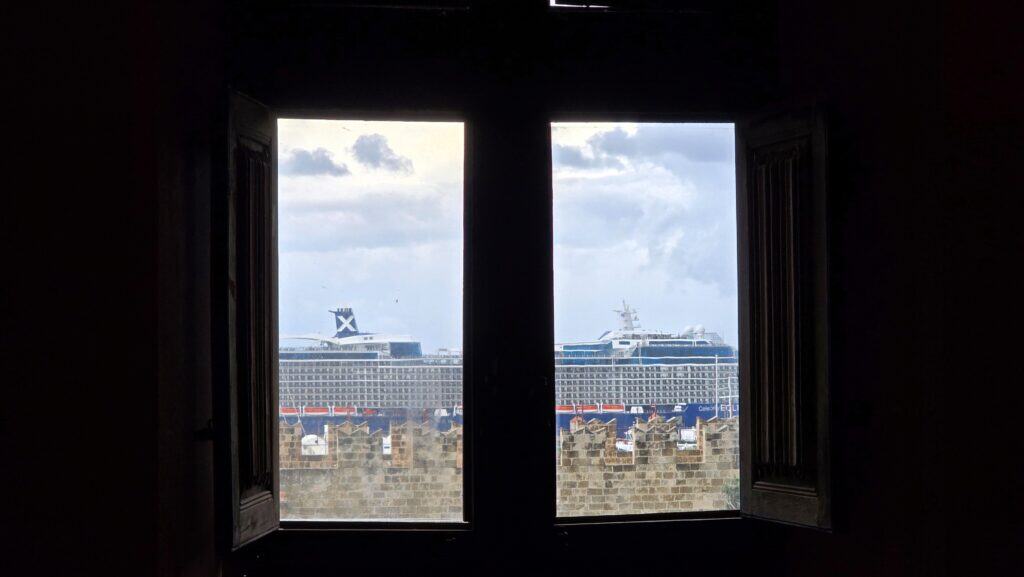
⚔️ Who Were the Knights? Mission and Function of the Order of St. John
To truly understand the Palace and the epic that unfolded within these walls, it is essential to know who its builders and defenders were: the Knights Hospitaller of St. John of Jerusalem .
They were not just soldiers, but a Monastic-Military Order, with a dual mission, which guided their existence from Jerusalem to Rhodes, up to Malta:
1. The Hospitaller Mission (Humanitarian Function)
Their original mission, from which the name “Hospitallers” derives, was purely charitable and sanitary.
- The Sacred Duty: The Knights’ first vow was to assist pilgrims in the Holy Land and to care for the sick and needy, regardless of their faith.
- The Hospital as Heart: The Knights’ Hospital (now the Archaeological Museum, our indoor refuge) was not an appendage, but the true heart of the Order. It was a cutting-edge facility for its time, symbolizing their commitment to the poor and suffering. For them, serving the sick meant “serving Our Lord himself.”
2. The Military Mission (Defense Function)
Over time, and with growing hostility in the Holy Land, the Order also became necessary for armed protection.
- The Protectors: In addition to the monastic vows of poverty, chastity, and obedience, they also took on the role of armed protection of pilgrimage routes. The Knights became the military elite of the Mediterranean.
- The Bulwark: When they lost the Holy Land, they settled on Rhodes in 1309, transforming it into an impregnable naval fortress . Their task was not only to defend themselves, but to serve as the last bastion of Christianity in the East , countering the expansion of the Ottoman Empire.
The Grand Master’s Palace and the Ancient Hospital are therefore two sides of the same coin: their military function (war) was inseparable from their charitable function (care).
🎥 The Three Voices of Destiny: From Conquest to Exile
One of the most engaging moments inside the Grand Master’s Palace is the room dedicated to the historical projection. It’s there that the walls come to life: three costumed characters take turns recounting, in the first person, three key events in the history of the Knights and the Castle itself. Hearing those voices, while the rain thundered outside, made the story incredibly vivid.
A major plus is that these videos are presented in English, with Greek subtitles being the secondary language, making the historical context highly accessible for English speakers. This immersive experience makes you fully conscious of the history. (A 10-second video clip confirming the English audio and Greek subtitles is available here as proof: https://youtu.be/PvuXPEpJeXA).
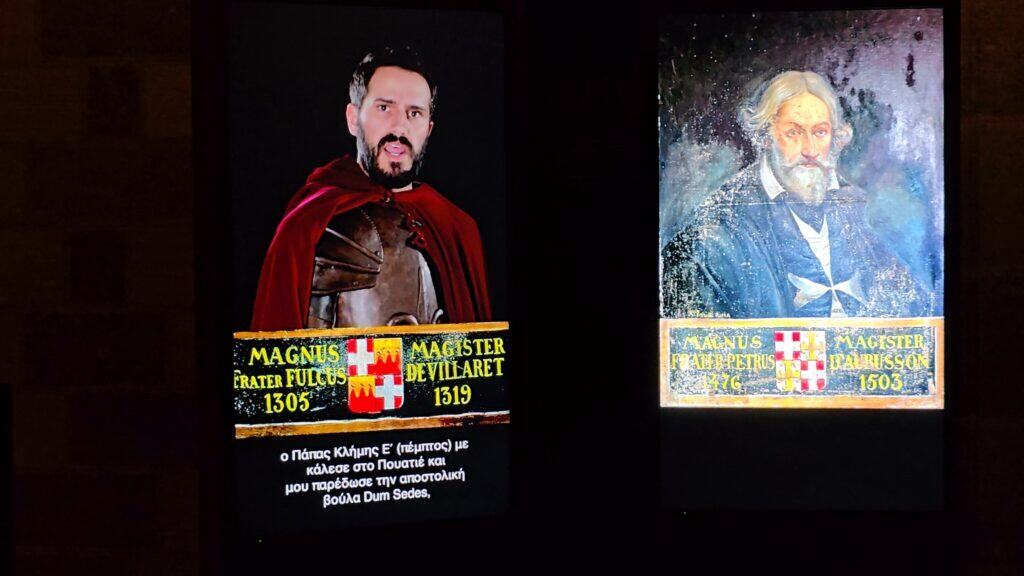
These are the three crucial stages narrated, which define the identity of Rhodes:
1. The Founder’s Voice: The Arrival and the Conquest (1309)
The first character introduces the moment of foundation, a period of great hope and new identity.
Historic Moment: The conquest of Rhodes by the Knights Hospitaller of St. John (Order of Jerusalem) in 1309. The Order, founded to assist pilgrims in the Holy Land, was left without a base after the fall of Acre. Rhodes became their new home and headquarters.
The Lived Story: This voice tells us of rebirth . How, after years of uncertainty, the Order found in this island a strategic fortress, a new beacon in the Mediterranean. It was the era of a grand vision: transforming a Byzantine city into an impregnable bastion, beginning the construction and strengthening of those same walls that today offer us shelter from the rain. Rhodes was no longer just a landing place, but the point of resistance for Christianity against the Ottoman advance.
2. The Defender’s Voice: The Test of Strength (1480)
The second figure evokes a period of maximum tension and construction, the moment when the Knights’ project was first seriously called into question.
Historic Moment: The Great Siege of Rhodes in 1480. Sultan Mehmet II (the same one who had conquered Constantinople) attempted a massive assault to eliminate the Order and open the way to the West. Despite the destruction and fire, the Knights and the population resisted heroically.
The Lived Story: This is the voice of resilience . It speaks to us of smoke, fear, and the struggle to rebuild the walls after each attack, a relentless labor of bricks and faith. After the siege, the Palace and fortifications were massively strengthened, an era of great military engineering, reminding us that this castle is not just a symbol, but a war machine designed for survival. This temporary victory gave Rhodes another 40 years of glory.
3. The Voice of the Exile: The Fall and the Retreat (1522)
The third and most melancholic character represents the moment of definitive defeat, but also the act of dignity in the face of history.
Historic Moment: The decisive Siege of Rhodes in 1522, led by Suleiman the Magnificent. After months of strenuous resistance, Grand Master Philippe Villiers de L’Isle-Adam was forced to surrender.
The Lived Story: This entry tells us about farewell . It describes the touching scene of their departure in January 1523: the defeated Knights marching in procession, receiving the honors of war from Suleiman, who recognized their valor. It is the narrative of their exile that ends with the promise of rebirth, the one that eventually brought them to Malta. Understanding this moment is crucial: the Castle we visit today is the memory of an honorable defeat, an abandoned place awaiting reconstruction (the Italian one in the 1930s), but one that has never lost its identity as a bulwark.
Hearing these three perspectives, one after the other, made us feel like the Palace wasn’t a cold museum, but rather the stage for an epic story spanning over two hundred years. It’s an experience not to be missed, adding depth to your indoor itinerary.
🔗 The Impact on the Lindos Acropolis
Gaining such a vivid understanding of the Knights’ history here in the Grand Master’s Palace provided us with the essential context to fully appreciate our subsequent visit to the Acropolis of Lindos. Only after learning about their history of fortification and resilience were we truly able to grasp the reason for that imposing medieval structure and better enjoy both historical phases of the site (the ancient Greek and the Knights’ era).
If you are planning your trip, we highly recommend following this order! For all our tips and the complete guide to the visit, you can read our detailed article here:
Acropolis of Lindos: First-Hand Tips, History, and Best Times to Visit
☕ Slow Lunch: The Flavors of Mama Sophia
Leaving the Castle, it was lunchtime. Despite it being early October, we noticed that many of the restaurants were packed, probably because the rain had driven everyone into the city.
Practical Note on Restaurants (Without Reservations)
We didn’t need to book, which is something to keep in mind for Rhodes (and we observed a similar process in Chora, Mykonos). Restaurants are used to large tourist influxes and, to maximize the number of available tables, prefer to manage the wait on the spot. Sure, you might have to wait a few minutes, but the staff is generally efficient in seating people as soon as a table becomes available. For them, it’s business; for us, it’s the guarantee of a hot meal and a covered table without the stress of booking!
A few steps away, we took refuge at the Mama Sophia taverna . Wanting to try a bit of everything, we opted for the mixed Greek platter (€50 for two), an excellent array of flavors that included musaka , meatballs, beef stew , giant beans, and the inevitable Greek salad with feta. A word of warning: Greeks love onions, which are abundant in several dishes, such as sausage and salad!
Mixed Plate Analysis: Tastings and Pricing Strategies
This dish is ideal for getting an overview of Greek cuisine in a single solution.
We immediately noticed (and recommend it) that it’s common to find mixed platters priced proportionally lower for two people than for one person. For the Mixed Greek Platter , the price was €30.00 for one person, but €50.00 for two. A great way to sample the variety at a more affordable price!
Our mixed platter included a great array of flavors, including:
- Moussaka: The quintessential Greek pie, made with aubergines, potatoes, ragù and béchamel sauce.
- Dolmades: Vine leaves stuffed with rice.
- Stifado Beef (Beef Stew): Slow-cooked stew with onions, perfect for warming up.
- Giant Beans (Fagioli Giganti): Baked beans in tomato sauce.
- Kebab and Meatballs
- Feta with Honey and Greek Salad.
A word of warning: Greeks love onions! We knew what to expect, and in fact, we were joking about the ingredients before the dishes even arrived. We found them abundantly in several traditional dishes, such as sausage and in Greek salad itself— I’d say they put them everywhere!
Video – 🍲 Rhodes: Rainy Day Comfort Food Showcase! (Hearty Greek Dishes & Sheltered Tavernas)
Find Your Warm Refuge with Greek Comfort Food The best part about a rainy day in Rhodes is having a legitimate excuse to dive deep into Greek comfort food while staying sheltered. Forget the rush; a wet day calls for slow-cooked dishes that soothe the soul. We recommend trying a rich Stifado or a classic, hearty Moussaka in a small taverna’s covered patio. Watch our short visual showcase below to see exactly what these amazing dishes look like and the kind of cozy atmosphere you can find.
Watch the following video directly here or on YouTube at the link: https://youtu.be/-VCHzFleuXA. If you are reading this article from your smartphone, scroll to the bottom of the page and exit the mobile mode to view it directly on this page.
🛍️ Alternative Exploration: Old Town, Shopping, and the Harbor
In moments when the rain gave us a break, we dedicated ourselves to exploration:
- The Street of the Knights: Very easy to find—just turn left immediately upon leaving the Castle.
- The Souq Atmosphere: Walking the parallel streets, you can easily get lost. The atmosphere is a mix of medieval history and an almost “Arabian” soul, reminiscent of a Souq.
- The Harbor and the Giants of the Sea: Just outside the walls, the contrast between ancient and modern is striking. It is fascinating to see the large cruise ships docking right next to the majestic fortifications.
- Practical Services: Public pay toilets are available along the route (50 cents).
🏛️ Archaeological Museum: The Knights’ Ancient Hospital
When the sky clouded over again, the Archaeological Museum was our second refuge. The entrance costs €10.
- The Real Highlight: The true reason to visit is the building itself: the Knights’ Ancient Hospital. The stone arches and the atmosphere alone are worth the entry price, transforming it from a typical museum visit into a historical exploration.
- Flexible Hours: The Museum is open late (until 8:00 PM), allowing you to maximize the sunny moments outdoors and take shelter indoors when the downpour returns.
🌧️ Rhodes When It Rains: The Ultimate Guide for a Perfect Vacation
Do not let the rain ruin your vacation in Rhodes! This beautiful Greek island is full of history and culture, much of which is housed in magnificent indoor spaces. An itinerary guaranteed to turn a rainy day into a rich and relaxing experience!
Rhodes in the Rain: Why Our Expectations Were Exceeded
Before arriving, we knew Rhodes was a city of immense historical value, especially the Old Town, and definitely worth visiting. We had studied its history and planned our spots. But honestly, the reality significantly exceeded our expectations, especially the historic center. The imposing walls and the feeling that the whole city is an open-air museum—you could walk the same streets multiple times and never tire of it.
Initially, seeing the amount of rain coming down, especially while we were driving, we laughed and said, “Well, at least we prepared well and parked the car close to the Castle entrance so we wouldn’t get completely washed away!” We weren’t worried, but we certainly weren’t thrilled about the intensity of the rain.
Fortunately, the variable weather ended up being a huge helper. The rain would stop, then start again. This mix of sun and showers allowed us to fully appreciate the indoor refuges, like the museums, and then slow down to enjoy the unique, glistening atmosphere of the cobblestone streets when the rain paused. This variable pace gave us so much time to enjoy the various shops and corners of the city.
We had considered rushing to see other things, like the Aquarium, but we were glad we didn’t force a rush. Focusing on the Old Town was a winning decision; we truly savored the atmosphere and the city. The ultimate lesson? Don’t be scared or discouraged by a downpour! Organizing yourself with indoor places to see means you don’t waste time, and you leave with a beautiful, unforgettable memory. We are certainly eager to return for new adventures and more Greek food!
FAQs
Is the Rhodes Archaeological Museum a good indoor activity for a rainy day?
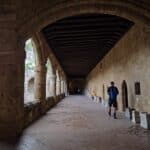
Yes, the Archaeological Museum is located inside the vast Old Hospital of the Knights. The massive stone arches and covered courtyards offer an impressive historical and cultural refuge on a rainy day in Rhodes Old Town.
What type of shoes should I wear to walk on Rhodes’ slippery cobblestone streets in the rain?

You should wear comfortable, closed-toe sneakers with rubber soles. This type of footwear provides the necessary grip and keeps your feet dry, ensuring safety and comfort on the wet, slippery cobblestone streets of the Old Town.
What Greek dishes are best for lunch in Rhodes when it’s raining?

Warm, hearty dishes are ideal for finding comfort. Opt for traditional plates like Moussaka or Stifado (beef stew), which are substantial and perfect for a cozy, slow lunch indoors while waiting for the rain to stop.
Does the rain in Rhodes ruin the view of the Mandraki Fortress walls?
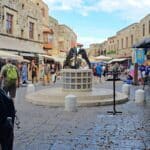
No, the rain often enhances the view! The vast wet ground on the promenade creates spectacular reflections of the massive medieval walls and the Tower of St. Nicholas, adding a dramatic, glossy atmosphere to the historic scene.
Can you still walk along the Mandraki promenade right after a heavy rain shower?
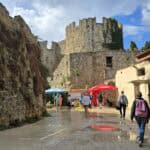
Yes, you can. The Mandraki promenade is wide and generally drains well, making it suitable for a walk immediately after the rain, as long as you have the right footwear. It is safe to enjoy the panoramic view of the fortress from this area.
Is the view of the Rhodes Fortress walls from the Mandraki Harbour impressive on a cloudy day?
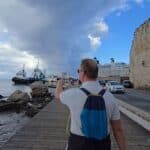
Yes, highly so. The contrast between the ancient, massive fortress walls and the modern ships in Mandraki Harbour is dramatic on a cloudy day, highlighting the city’s unique history as a port of entry.
Rhodes City Rainy Day Map: Best Indoor Activities & Sheltered Tavernas
Don’t let a sudden shower ruin your plans! We’ve created this custom Rhodes City Rainy Day Map to guide you instantly to the best shelter options.
This interactive tool filters out all the open-air confusion, showing you only the essentials: Core Indoor Culture (like the Knights’ Hospital), Extended Indoor Activities (in the New Town), and all the best Sheltered Tavernas where you can enjoy your Greek comfort food. Zoom in, click the pins, and start exploring your perfect rain-proof itinerary!
When to Visit Rhodes, Greece: A Month-by-Month Guide
Timing Your Trip to Rhodes, Greece: A Comprehensive Monthly Overview. Check out the linked article for more details.


